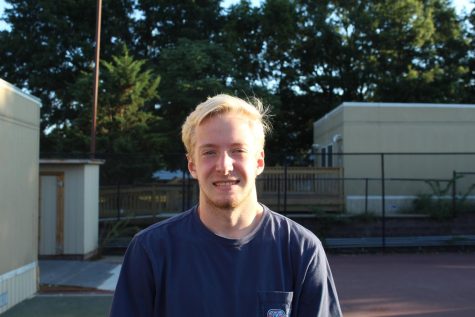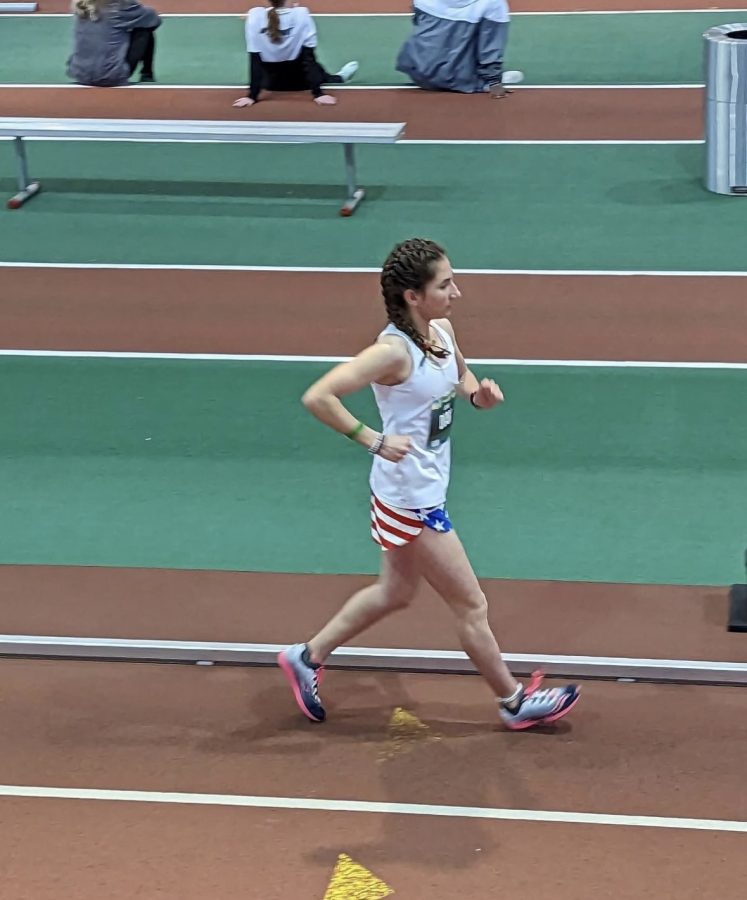Art of the (Race) Walk: Roma Diak walks to National Championship
When one thinks of track & field, chances are that it’s the marquee events and their iconic athletes that come to mind – the lightning speed of the sprinters and hurdlers, the enviable endurance of the distance runners, the high-flying pole vaulters, or the rugged yet artful hammer throwers. Perhaps race walking, derived from the sport of pedestrianism – a professional, often gambling-funded form of competitive walking – isn’t the first that piques the interest.
Those familiar with the art of race walking might have even had a chuckle at the race walker’s unique form. But the skill of these athletes is undeniable. For sophomore Roma Diak, whose most recent mile walk time sits at just over nine minutes, race walking is no laughing matter.
“You have to land on your heel, then roll onto your toe, and it’s just a very strange, weird-looking thing,” said Diak. “It’s very different than normal walking, and you need to move your arms differently. It’s kind of a weird rhythm you have to get into.
“I’m definitely a lot more sore after walking than running. They both just take endurance; like I do distance during track… and it’s a similar kind of effort level.”
At the Last Track to Philly invitational on January 21st, the last meet on the indoor track schedule to offer the mile race walk, Diak competed for only the second time. She went on to win the entire event outright, eclipsing the rest of the girls’ field by nearly two minutes and even finishing eight seconds ahead of the boys’ winner.
The personal best time which she walked in that event comfortably qualified her for the Nike, New Balance, and Adidas-sponsored trio of national meets. The cut time was 9:20; Diak completed her walk in 9:07.
“I didn’t even know that [Nationals] was a thing, first of all that I could achieve, and then I had no clue what the times were or anything,” Diak said. “I finished and [Coach Prasad] Gerard was like ‘Oh, I wonder what the qualifying times are for Nationals?,’ and the next day he emailed me and was like, ‘Oh, you qualified for nationals.’
“I was very excited and surprised and I was like, ‘Okay, I guess I’m doing this, I guess this is going to be a thing.’”
One of the most surprising aspects of Diak’s success is that she only walked competitively for the first time last spring. She won her first race by more than 30 seconds, even though her training regimen consisted of just one brief pre-meet clinic.
Only recently, as she prepared for the national meets, has Diak begun working with a race walking coach. Although her story seems to downplay the sophistication of the sport, race walking isn’t as ‘pick up and play’ as it might seem.
Admittedly, there are only two rules. First of all, walkers must keep one foot in contact with the ground at all times. If they don’t, it’s officially referred to as “loss of contact,” referred to colloquially as “flying.” Secondly, the supporting leg needs to remain straight until the body has passed over it, a very complex way of stating that they need to actually be walking.
How are these rules upheld? Well, the judges eyeball it. So, one’s feet can both leave the ground at the same time, as long as the human eye can’t detect it. Walkers are shown a yellow paddle by the judging panel if they’re deemed to be “at risk” of breaking form and a red paddle if an egregious form break is detected. If a competitor is shown three red paddles, they’re officially disqualified from the event — and it can be quite brutal.
Spare a thought for Australian race walker Jane Saville, who was denied the gold medal in front of her home crowd at the Sydney Olympics after she was disqualified in sight of the finish line. Keep in mind that she was competing in a 20-kilometer race — that’s over 12 miles. The longer of the sport’s two World Championship-recognized events is 50 kilometers (31 miles), and the men’s world record saw Frenchman Yohann Diniz walking for over three and a half hours. Over that eye-watering distance, Diniz maintained an average pace under seven minutes per mile.
As for Diak, she recently competed in the Nike Indoor Nationals meet, held at The Armory in New York City. She finished 14th in the nation, posting a personal record of 9:02.97.
“I enjoy race walking,” she said. “It’s kind of like a hidden talent.”

Jack is a senior in the Humanities program. This is his second year writing for The Pulse, but his first year as a Copy Editor. Outside of the classroom,...











